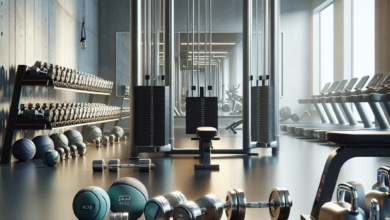Best Workouts for Muscle Building at the Gym!

Embarking on a muscle-building journey requires a strategic approach to gym workouts. Unleashing muscle growth isn’t just about lifting weights; it’s about executing the best gym muscle building workouts with precision and control. To kickstart this process, compound exercises like squats, deadlifts, and bench presses should be at the core of your routine. These movements engage multiple muscle groups, allowing you to lift heavier weights and stimulate growth more effectively.
Additionally, it’s crucial to pay attention to workout volume and frequency. Striking the right balance will prevent overtraining while maximizing gains. As a general rule, aim for 3-5 sets of 6-12 reps per exercise, with a focus on progressively increasing the weight as your strength improves. Remember, quality trumps quantity when it comes to reps and sets. Each movement should be performed with full range of motion and proper form to both prevent injury and optimize muscle engagement.
Lastly, consistency is key. Regular workouts, ideally 4-6 times a week, coupled with adequate rest and nutrition, will ensure that your muscles have the stimulus and resources they need to grow. And don’t forget, recovery is just as important as the workout itself; make sure to incorporate rest days into your routine. Explore More at Muscle Theory for detailed workout plans and recovery tips to make the most of your gym time.
Top Exercises for Maximum Muscle Stimulation

For those seeking to maximize their muscle gains, certain exercises stand out for their efficiency in stimulating a broad range of muscle fibers. The squat reigns supreme as a lower body powerhouse, targeting the quadriceps, hamstrings, and glutes as well as the core. Deadlifts follow closely, known for their unparalleled ability to engage the posterior chain, which includes the back, glutes, and hamstrings.
Moving to the upper body, the bench press is a quintessential exercise for chest development, also recruiting the shoulders and triceps. For a more comprehensive shoulder workout, the overhead press is unmatched in its ability to sculpt the deltoids. To target the back and improve overall pulling strength, nothing compares to the pull-up and bent-over row.
It’s not just about the primary movers, however. Incorporating isolation exercises like bicep curls and tricep extensions can enhance the size and definition of these muscles, which are often the showpieces of strength. Moreover, calf raises and leg curls fine-tune the legs, ensuring no muscle group is left behind. Each of these exercises should be performed with a focus on mind-muscle connection—consciously engaging the target muscle throughout the movement for peak stimulation.
While these exercises are effective, it’s essential to tailor your workout to your individual needs and goals. Continuously challenging your muscles with varying weights, rep ranges, and techniques such as supersets and drop sets will keep the gains coming and prevent plateaus. By incorporating these top exercises into your regimen, you’re setting the stage for maximum muscle growth and a well-rounded physique.
Creating the Perfect Muscle-Building Gym Routine

Achieving the pinnacle of muscle growth necessitates a well-structured and strategic gym routine. The perfect muscle-building routine is a symphony of compound and isolation exercises, orchestrated to work each muscle group effectively. Begin by scheduling your workouts over a week, allowing ample time for different muscle groups to recover. Common splits include upper/lower, push/pull, or a more targeted approach like a 5-day split focusing on different body parts each day.
Compound movements should form the backbone of your program. Exercises such as squats, deadlifts, and bench presses not only work multiple muscles simultaneously, but they also trigger a significant hormonal response that fosters muscle growth. These exercises should be performed early in your workout when you’re at your freshest and strongest. Aim for heavier weights and lower reps to stimulate type II muscle fibers, which have the greatest potential for growth.
After the heavy lifting, shift focus to isolation exercises to target individual muscles. Here, you might increase the reps to fully exhaust the muscle and promote hypertrophy. Incorporating variations in grip, stance, and equipment can also stimulate growth by challenging the muscles from different angles. Cable machines, dumbbells, and barbells each offer unique benefits and should be utilized for a varied and effective routine.
Finally, recovery is a critical component of any muscle-building routine. Ensure each muscle group has at least 48 hours of rest before being worked again, and don’t underestimate the power of sleep and nutrition in the growth equation. With a routine that balances intensity, variety, and recovery, you’ll be well on your way to achieving your muscle-building goals.
Nutrition for Muscle Gain: What to Eat Post-Workout

Refueling your body after a grueling workout is crucial for muscle gain. The post-workout meal is a window of opportunity to speed up recovery and stimulate muscle hypertrophy. The emphasis should be on a combination of fast-digesting proteins and carbohydrates to replenish depleted glycogen stores and to shuttle amino acids into the muscle cells.
Protein is the building block of muscle tissue, and consuming it post-workout aids in repairing and building the muscles worked during your session. Whey protein, for instance, is a popular choice due to its rapid absorption rate. Aim for 20-40 grams of protein after your workout to kickstart the recovery process.
Carbohydrates are equally important as they restore glycogen levels, which have been exhausted from your training. Fast-acting carbs like white rice, potatoes, or even fruit can quickly restore glycogen and help transport protein to your muscles. The ratio of carbs to protein can range from 2:1 to 1:1, depending on your individual energy needs and goals.
Do not overlook hydration and micronutrients. Rehydrating with water or an electrolyte-rich drink is vital to replace fluids lost through sweat. Additionally, incorporating vegetables or a piece of fruit can provide essential vitamins and minerals that aid in recovery and overall health.
Remember, timing is also key. Consuming your post-workout meal within 30 to 60 minutes after exercising can maximize the benefits of muscle repair and growth. By ensuring your body receives the nutrients it needs post-workout, you’ll be setting the stage for optimal muscle gain and improved performance in your next gym session.
Optimizing Rest Periods for Muscle Recovery

The concept of rest and recovery is often undervalued in the muscle-building process, yet it is as critical as the workouts themselves. Proper rest periods between sets and after workouts can significantly impact your muscle growth and overall strength. The rule of thumb for hypertrophy training suggests taking 30 to 90 seconds of rest between sets to allow for sufficient muscle recovery while maintaining the intensity of your workout.
Longer rest periods are generally recommended for strength-focused training where maximal muscle recruitment is necessary. Here, rest intervals of 2 to 5 minutes may be optimal to fully recover ATP stores, which are the primary energy source for high-intensity, short-duration activities like lifting heavy weights.
It’s not just the intra-workout rest that matters; the days off between gym sessions are equally essential. Muscles need time to repair and grow, and that growth occurs outside the gym. For most people, it’s beneficial to have at least one full day of rest between workouts that target the same muscle groups. Overtraining can lead to diminished results and increase the risk of injury.
Listen to your body and adjust your rest days and periods according to how you feel. Factors such as sleep quality, stress levels, and diet all play a role in how quickly your body recovers. Incorporating active recovery methods, like light cardio, yoga, or stretching, can further enhance recovery and muscle growth. By optimizing rest periods and recovery time, you’ll be able to return to the gym stronger for your next session and continue making gains in muscle size and strength.
Advanced Training Techniques for Experienced Lifters
For the seasoned gym-goer looking to break through plateaus and stimulate further muscle growth, advanced training techniques can be the key to unlocking new levels of strength and hypertrophy. Techniques such as drop sets, supersets, and eccentric loading are designed to push muscles beyond conventional fatigue and encourage adaptation.
Drop sets involve performing a set to failure, then reducing the weight and continuing to perform more reps until failure is reached again. This method helps to exhaust the muscle fibers and promote endurance alongside hypertrophic gains. Supersets, on the other hand, can be employed to increase workout intensity and density by pairing sets of two different exercises with no rest in between—often opposing muscle groups for balance and recovery.
Eccentric loading focuses on the lengthening phase of a lift, which can cause more muscle damage and therefore potential for growth. By slowing down the eccentric phase, or even incorporating additional weight during the eccentric part of a lift, you can significantly challenge your muscles and spur growth.
It’s important to note that these techniques should be used judiciously, as they can be very taxing on the body and require more recovery time. As with any training regimen, ensuring proper form and listening to your body’s feedback is paramount to avoid injury. For those ready to take their training to the next level, integrating these advanced techniques can be a powerful tool in your muscle-building arsenal.
Ready to elevate your gym game with advanced training techniques? Explore More at Muscle Theory for in-depth guides and expert advice to help you maximize your muscle-building potential.
Visit muscletheory.com to learn more about implementing these advanced strategies into your workout routine and continue your journey towards peak physical fitness.



